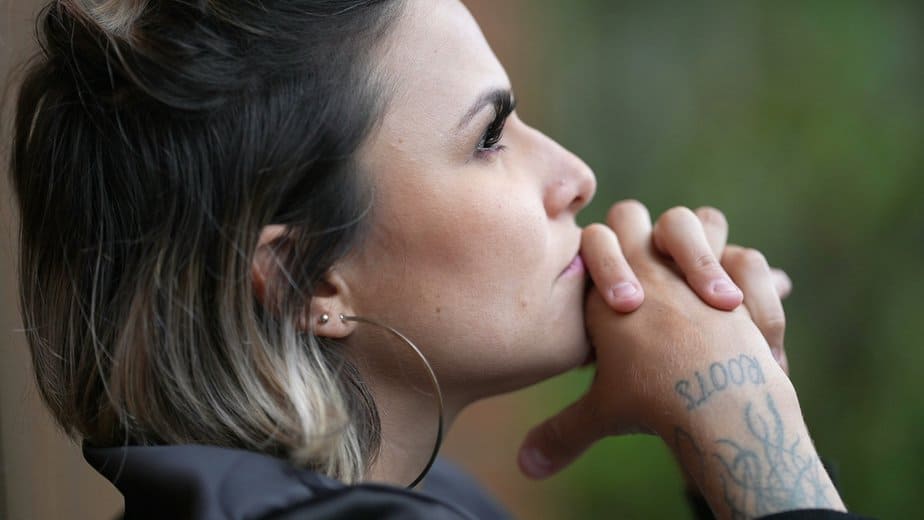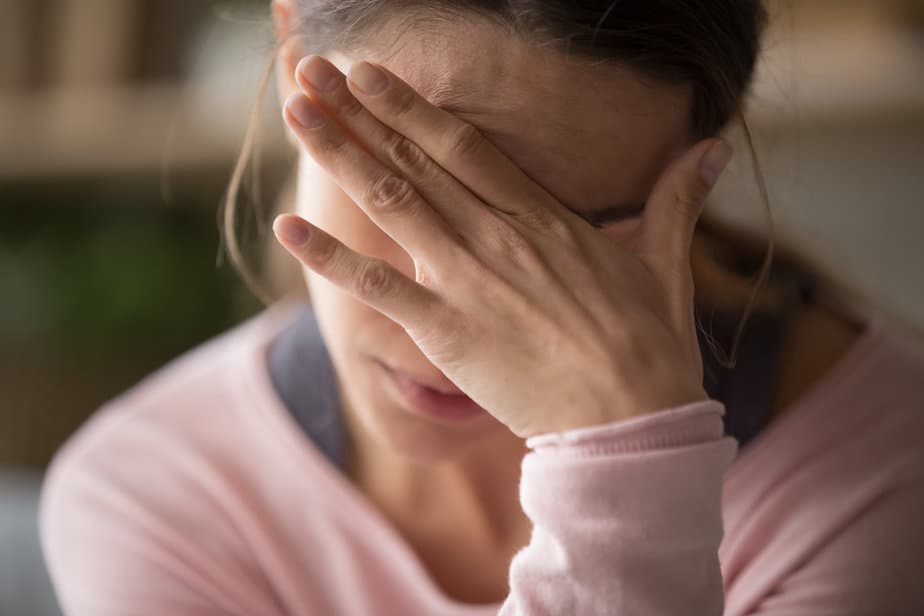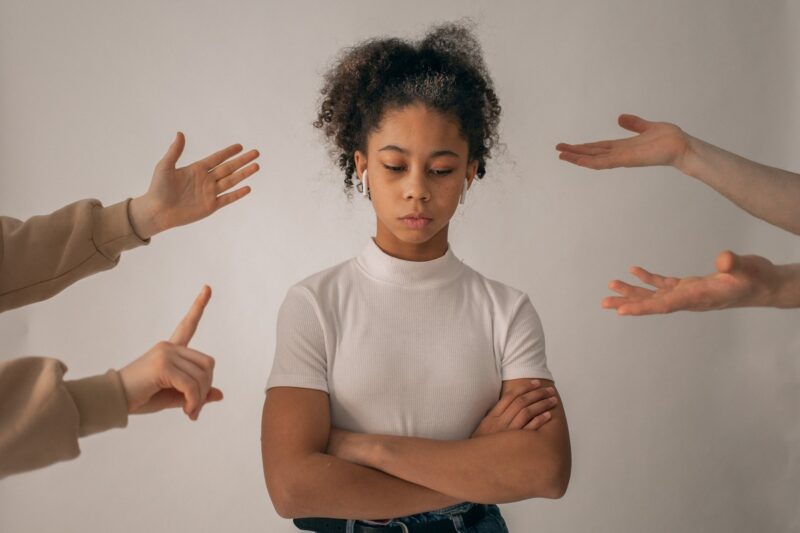Body Language Of Shame: 10 Nonverbal Red Flags To Note

Shame can be defined as an unpleasant emotion that can affect the way we behave and communicate with others. When you experience the emotion of shame, no matter what you do, you might end up feeling perpetually bad, broken, and unlovable. What are the signs of body language of shame?
Maybe you’re trying to understand the patterns of your behavior better. Maybe you’re struggling to understand the people around you when they’re dealing with the emotion of shame. We can detect shame by observing body language signs and signals that indicate discomfort, anxiety, or dishonesty.
What does body language of shame entail, though? When we’re talking about body language, we’re referring to the conscious and unconscious nonverbal cues we use to communicate with each other. Although we communicate with words, nonverbal signals make up a huge part of our daily communication.
Whether we resort to gestures, mannerisms, expressions, posture, body movements, or even the tone of the voice, we turn to body language to understand ourselves and others better. Words are great, but the things we don’t say oftentimes carry more meaning than the things we do say.
By figuring out how to read the body language of shame, you might be able to pinpoint whether you’re suffering from the perpetual emotion of shame without knowing. Before you turn your back on someone you’re close with, you might even figure out whether they’re affected by shame, too. So, what’s the tea?
What is shame?

We need to start by saying that shame and guilt are not the same emotions. Guilt might be defined as a “simpler” emotion where you’re overridden with guilt because you think you’ve done something wrong. Shame, on the other hand, develops when you think that you are wrong or that you are a mistake.
People who experience the emotion of shame typically report that they’re battling a critic inside their heads who keeps telling them they’re wrong, worthless, or that they’re bad people. We do need to mention that there are two types of shame to differentiate between.
State shame or temporary shame typically occurs as a response to a specific situation. Maybe you’re ashamed because you’re surrounded by people who’ve seen you at your lowest. Maybe you’re worried that the people you’re with are talking behind your back because of something you did.
Trait shame, on the other hand, exists whether or not you’re surrounded by people. Trait shame occurs because you believe you’re supposed to suffer because of something you did or because that’s the type of person you are. You’re ashamed of yourself, whether or not you have a reason to be.
When you’re perpetually ashamed of yourself, you believe that you’re a bad person and that there’s nothing you can do to redeem yourself. Now, you might think that nobody can detect the shame you feel, but you’re wrong. With a little help from the body language of shame, you can detect whatever is being presented.
10 tell-tale signs of body language of shame
1. A “sunken” posture

When you’re ashamed, you tend to want to disappear when you’re surrounded by other people. You’re ashamed of something you’ve done and you don’t want anyone confronting you about that. You want to hide your face, your body, and you want to remove yourself from the situation entirely.
What do we mean by a “sunken” posture? Poor posture can be connected with a myriad of both physical and mental problems. Sunken shoulders, lowering your head, looking down, and avoiding eye contact are all signs that you’re feeling unworthy and that you’re trying to avoid letting anyone see you that way.
2. Reddening of the face
“Argh, why do we become red when we’re embarrassed or ashamed!?” When you’re trying to hide your face from the rest of the world, the worst thing that can happen to you would be to suddenly become flushed. Reddening of the face can be seen as one of the most common signs of shame.
With the right stimulus, the nerves prompt the blood vessels to open wide and flood the skin with blood – giving you the red color you’re trying to run away from. Shame and embarrassment can cause a sudden rush of blood to your cheeks and expose your emotions to everyone you’re feeling.
What a shame!
3. Avoiding eye contact
Avoiding eye contact might be common among people suffering from social anxiety, depression, and an array of mental health problems, but that doesn’t mean that people who are simply suffering from shame are above hiding their eyes.
Quite on the contrary, they’re known to look everywhere except where they’re supposed to look.
When you’re talking to someone who might be experiencing emotions of shame and embarrassment, you might notice them looking around the room, checking their phone, and looking like they’re trying to find the right moment to run away.
Well, that’s because they are. People who are ashamed are known to avoid eye contact because they’re too weak to endure the look of the person who might be the cause of their shame.
4. Maintaining eye contact

With that out of the way, though, we can say the same thing about maintaining eye contact. We’re all different which means we deal with the emotions of shame and embarrassment differently. What does that mean?
People who are ashamed because of something they’ve done might maintain eye contact to try to appear more honest and honorable. Because they’re trying to cover what they’re going through, they’re pretending that they’re completely at peace with the person they’ve wronged.
People who are trying to hide the fact that they’ve done something wrong might end up smiling, nodding, and acting surprised when confronted, too.
5. Slumped shoulders
We mentioned before that bad posture typically signals that there’s something wrong. Whether you’re angry, agitated, or ashamed, you might end up slumping your shoulders because you’re unable to stand up straight. People who stand up straight are confident, honest, and have nothing to hide, right?
People who slump their shoulders, cross their arms, and cover their mouths, on the other hand, are ashamed of something they’ve done or someone they’ve wronged. Slumped shoulders aside, you might notice them showing signs of tension, such as clenching their fists or tapping their feet.
6. Frowning or lip biting
Whether you’re frowning or biting your lip, you’re showcasing signs of anxiety. We’re talking about shame, but anxiety happens to be one of the most common byproducts of shame. When you’re ashamed because of something you’ve done, you’re guaranteed to experience some of the symptoms of anxiety, too.
People who frown or bite their lips might be doing that for a million other reasons, too, but that’s why you need to look at the bigger picture. Are they avoiding eye contact? Are they slouching, twitching, and sweating? Are they talking too fast or stuttering? Answer these questions and you’re good to go.
7. Twitching, sweating, or trembling

When you’re ashamed, your body wants to take over and do whatever. Whether you’re twitching, sweating, or trembling, the reason for that might be that you’re ashamed of something.
Starting with twitching, your brain might be interpreting your anxiety as stress and sending signals to your body that trigger muscle spasms. Sweating occurs when your heart starts racing and your nerves start to get the best of you.
When you’re ashamed of something you’ve said or done, you might start sweating because your body might be trying to cool off and calm down. Trembling occurs when your body thinks you’re in danger because you’re going through such emotional turmoil.
8. Stiffness
We’ve all been there – unable to move because we’re overtaken with shame and embarrassment because of something we’ve caused. When you experience the emotion of shame, you might become stiff because you’re trying not to draw attention to yourself.
You might sit still, avoid making gestures, and even create barriers with different objects. You might lean back or turn away for the same reason, too.
We do need to mention that gestures and postures vary from person to person. Some people become stiff when they’re ashamed, but others might use gestures to try to explain themselves, emphasize, clarify, or express their points.
9. Hiding of the face
Embarrassed people are oftentimes motivated to avoid social contact with anyone. Whether that means they’re opting to stay at home when they’re supposed to go to work or they’re hiding their face when they’re talking to people they don’t want to talk to, that’s up for discussion.
Most people instinctively cover their faces when they’re ashamed so that others are less likely to notice their red, flushed appearance. With that in mind, though, some people might be more inclined to show their face to restore the positive image that has been tarnished by the embarrassing event.
10. Stuttering

We can’t forget about stuttering, right? Stuttering might be more connected with anxiety, nervousness, and similar emotional responses, but you’d be surprised at the number of people who stutter because of shame.
When something embarrassing happens, you might be too nervous to speak to people who witnessed the event. Stuttering is not necessarily a sign of shame, but shame might make your stuttering more severe, too.
Read more: Body Language: How To Understand The Words We Don’t Speak






